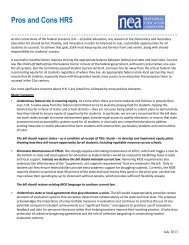KEA Executive Director's Report - Kentucky Education Association
KEA Executive Director's Report - Kentucky Education Association
KEA Executive Director's Report - Kentucky Education Association
You also want an ePaper? Increase the reach of your titles
YUMPU automatically turns print PDFs into web optimized ePapers that Google loves.
March 2013<br />
TO:<br />
FR:<br />
RE:<br />
<strong>KEA</strong> Delegates<br />
Mary Ann Blankenship<br />
<strong>KEA</strong> Delegate Assembly<br />
<strong>Report</strong> of <strong>KEA</strong> Staff Activities since the 2012 Delegate Assembly<br />
I hope each of you will join me in thanking <strong>KEA</strong> staff who have absorbed more work this year as we<br />
have left some vacant staff positions unfilled. Almost all staff have picked up more work during this<br />
past year.<br />
Summarizing the work for nearly seventy staff over a full year is nearly impossible. Consequently, I<br />
highlight a few of the more notable activities, organized around <strong>KEA</strong>’s operational goals.<br />
Member Rights<br />
1. Individual Advocacy: <strong>KEA</strong> has maintained its strong history of advocating for individual<br />
members’ rights, both from advice and assistance from UniServ staff and from attorneys.<br />
2. Organizational Relations: <strong>KEA</strong>’s presence and relationships with both local and state<br />
decision makers assures that members’ needs and rights are considered and included in<br />
deliberations.<br />
3. Local Advocacy: <strong>KEA</strong> equipped its local association leaders in advocacy activities with their<br />
local school board, especially around financial and professional issues. <strong>KEA</strong> assisted<br />
bargaining and non-bargaining locals with their local organizing and advocacy activities.<br />
4. Superintendent and Principal Selection: <strong>KEA</strong> advised and trained members to assure<br />
that they exercised their rights as teachers and as SBDM council members.<br />
5. Troubled School Districts: As management problems in more school districts came to light<br />
this year (whether because of reviews by the State Auditor’s office or KDE), <strong>KEA</strong> assisted its<br />
leaders and members in assuring that members’ voices were heard and they were<br />
protected.<br />
Membership Development<br />
1. Training: <strong>KEA</strong> developed and piloted new membership training to give recruiters skills and<br />
help them target. <strong>KEA</strong> also provided training to ARs, emerging leaders, and local officers,<br />
each with a component of membership recruitment and engagement.<br />
2. Communication: <strong>KEA</strong> enhanced its communication with members and non-members this<br />
year, with redesign of www.kea.org, more Facebook presence, better face-to-face contacts,<br />
and new membership videos.<br />
3. Outreach to New Professionals: <strong>KEA</strong> has increased its communication and outreach to<br />
younger members, knowing they will lead the association of the future and are also key to<br />
increasing <strong>KEA</strong>’s membership.<br />
4. Leadership Development: Knowing the strong local officers and <strong>Association</strong><br />
Representatives are key to <strong>KEA</strong>’s ongoing success and growth, <strong>KEA</strong> continues to focus on<br />
recruiting and training these local leaders.<br />
5. Community Outreach: Since school employees support their local communities every day<br />
in both their professional and personal commitments, <strong>KEA</strong> has assisted locals in organizing<br />
Read Across America activities and the student program in its annual outreach to teach<br />
activity, this year in Magoffin County.
Strong Locals<br />
1. Member Collaboration: More local are working well across all categories of membership –<br />
classified members, certified members, retired members and student members. Several<br />
locals have merged their certified and classified groups into one united organization.<br />
2. Treasurers’ Training: <strong>KEA</strong> has created and began delivering training for local treasurers.<br />
Request this training through your UniServ director.<br />
3. UniServ Study: In response to NEA 2 from 2012, <strong>KEA</strong> has begun a study of the way that<br />
<strong>KEA</strong> assigns work to UniServ staff, in an effort to create an equitable way to serve all<br />
members’ needs appropriately.<br />
4. Electoral Involvement: <strong>KEA</strong> worked with members to become more involved in local<br />
school board elections and to maintain a Democratic majority in the <strong>Kentucky</strong> General<br />
Assembly. KEPAC continued to develop its county-focused structure to enhance members’<br />
political engagement.<br />
5. Lobbying Involvement: The 2013 General Assembly session saw significant changes, with<br />
a more bipartisan atmosphere, which resulted in more bills passing. Unfortunately, among<br />
these bills was one that changes the structure of the pension system for all classified<br />
employees hired after January 1, 2014, while not assuring that the pension systems are<br />
funded. Most troubling, legislators show no inclination to resolve the state’s financial<br />
problems more generally.<br />
Strong Profession<br />
1. Regulations: <strong>KEA</strong> has become more involved this year in advocacy around proposed<br />
regulations to assure that they are consistent with the law, enhance the education<br />
professions and also protect members.<br />
2. Teaching Quality: As the development progressed of the Professional Growth and<br />
Effectiveness System, <strong>KEA</strong> members and staff devoted significant time to advocacy related<br />
to this huge priority. <strong>KEA</strong> enhanced its support programs for candidates for National Board<br />
Certification and with the national board leadership.<br />
3. TELL <strong>Kentucky</strong>: <strong>KEA</strong> was instrumental in <strong>Kentucky</strong>’s record-setting participation in the<br />
second administration of the TELL <strong>Kentucky</strong> survey in March 2013.<br />
4. Focus and Priority Schools: <strong>KEA</strong> offered informational sessions for members in focus and<br />
priority schools and worked with KDE on services offered to these schools.<br />
5. <strong>KEA</strong> TALK: <strong>KEA</strong>’s new Teaching Advocates Leading <strong>Kentucky</strong> is advising the association on<br />
communications with educators about PGES and implementation of the common core and<br />
<strong>Kentucky</strong>’s new assessment and accountability system. This work is underwritten by a<br />
grant from the NEA Foundation, with funding coming from the Bill and Melinda Gates<br />
Foundation. TALK will sponsor a conference in June in Louisville.









